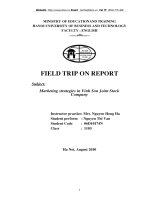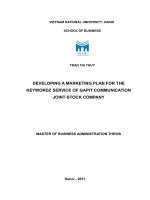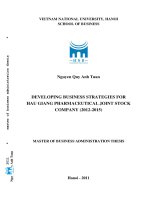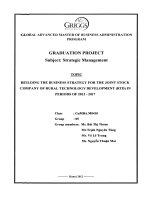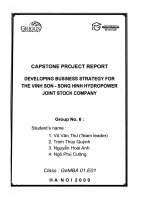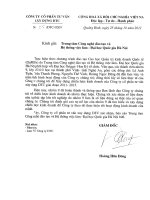Developing marketing communication strategies for summit joint stock company
Bạn đang xem bản rút gọn của tài liệu. Xem và tải ngay bản đầy đủ của tài liệu tại đây (1.49 MB, 79 trang )
1
FOREIGN TRADE UNIVERSITY
FACULTY OF BUSINESS ENGLISH
--------***--------
GRADUATION THESIS
Major: Business English
DEVELOPING MARKETING COMMUNICATION
STRATEGIES FOR SUMMIT JOINT STOCK
COMPANY
SUBMITTED IN PARTIAL FULFILMENT OF THE REQUIREMENTS FOR THE
DEGREE OF BACHELOR OF ARTS IN BUSINESS ENGLISH
Student full name: Nguyen Minh Hang
Student ID
: 1817710053
Class
: Anh 02
Intake
: K57
Supervisor
: Hoang Ngoc Thuan, PhD
2
Hanoi, June 2022
3
TABLE OF CONTENTS
LIST OF FIGURES
4
ACKNOWLEDGEMENTS
During the researching process, I receive plenty of enthusiastic help and
support that guide and encourage me to overcome all difficulties and finish this hard
but meaningful time.
Firstly, I would like to express thanks to Foreign Trade University and the
Faculty of Business English for creating favorable conditions for me to finish my
graduation thesis. In particular, I would like to express my deep gratitude to Mr.
Hoang Ngoc Thuan for his support and enthusiastic instructions.
Secondly, I would like to express my gratitude and appreciation to my
collegues at Summit Joint Stock Company for giving me valuable experiences, not
only knowledge and skills at work but also how to behave in the working
environment.
Thirdly, I am grateful to all of the lovely students of Summit Education.
In short, I really thank all the people helping me to finish this graduation
thesis.
Sincerely,
Nguyen Minh Hang
Hanoi, May 2022
5
INTRODUCTION
1. Research rationale
In the market economy, along with the open-door integration policy with many
opportunities and challenges for development, Vietnamese enterprises have to face
fierce competitive pressure, especially in the context of the economic recession. In
the global economy, Vietnamese businesses face more and more difficulties.
Therefore, in that situation, the task for the managers is to improve the
competitiveness of the business, and at the same time, to always be dynamic and
creative, to make accurate business decisions, to take responsibility for the future
business results, preserving business capital and more importantly, bringing profits
to the business. This would be very difficult without perfect marketing
communication strategies.
In the age of the Internet and e-commerce, businesses do everything they can
to promote their brands and products. To be able to stand out and be highly
competitive, businesses need to have an effective marketing strategy to attract
customers to choose their products and services. Communication is one of the major
contributors to build and sustain long term relationships. Finding out what
company’s customers and prospects really value and building the communication on
it will help companies to retain existing customers and also attract new customers
(Nasir, 2015).
Enterprises in the education sector are also not out of the competition in terms
of marketing strategies. They especially focus on brand promotion and marketing
communication to attract students.
Summit Joint Stock Company was established in 2010. With the capital
contribution of three main shareholders, Summit at that time was one of the leading
enterprises in the field of teaching IELTS, SAT, English for Junior and studying
abroad consultancy. Therefore, during their first years of operation, Summit did not
need to spend a lot of money on marketing communication activities but still had
many students attending, becoming one of the most prestigious and quality learning
systems in Hanoi and Ho Chi Minh City. However, in the past few years, the
competitive environment of English education has become increasingly fierce.
6
Summit's competitors have increased significantly and their plus point is knowing
how to take advantage of marketing communications in many media. As a result,
despite many years of experience in the industry, Summit is also showing signs of
lagging behind nascent systems in terms of branding and communication, causing a
significant market share. Nowadays, more and more foreign language education
institutions and English centers are established, so that consumers will have more
choices for educational services. Each organization has a different method of
communication and promotion, creating a unique feature to enhance its reputation
in the market. Therefore, in order to maximize the number of customers using its
education services, Summit Joint Stock Company needs to have breakthrough
marketing communication strategies, contributing to improving competitiveness
compared to competitors in the market.
Considering the above issue, the author has chosen the topic "Developing
Marketing Communication Strategies for Summit Joint Stock Company" to study
more deeply the Marketing communication activities of Summit Joint Stock
Company. From there, the thesis gives practical and appropriate solutions to
improve marketing communication activities and improve the competitiveness of
enterprises.
2. Previous studies
Currently, marketing communication issues are a common concern of all
businesses, many research topics have contributed significantly in analyzing
marketing activities in businesses, giving appropriate marketing solutions and
feasible to implement.
Nguyen Quoc Thinh and Nguyen Thanh Trung (2012), “Brand with
Managers”. The book has fully presented the basic concepts of brand
communication and brand management and the urgency of the brand with the
development of enterprises. Along with that are brand updates in modern marketing
activities.
Suphan Nasir (2015), “Marketing Strategies in Competitive Markets and
Challenging Times”. This study has emphasized the importance of marketing
7
strategies in the relationship between customers and businesses, customer insight
and customer satisfaction.
Finne, Å. and Grönroos, C. (2017), "Communication-in-use: customerintegrated marketing communication". This study concentrates on developing a
customer-centric marketing communications approach that takes the starting point
in the customer ecosystem.
Oana Duralia (2018), “Integrated marketing communication and its impact on
consumer behavior”. The goal of the study is to highlight the main tools that
specialists use in integrated marketing communication in order to establish a
permanent and efficient contact with both potential and actual customers, as well as
a secondary data analysis of the impact of false news broadcast through different
media channels on consumer attitudes. The study of consumer behavior is essential,
because consumers are an important factor to increase revenue and develop the
position of the business. Therefore, identifying consumers' buying habits of
products and using services will help businesses come up with appropriate
communication strategies that target the familiar shopping habits and behaviors of
customers.
E S Soegoto and A T Utomo (2019), “Marketing Strategy Through Social
Media”. This study aims to analyze marketing communication through social
media. It can be said that social networks are now the fastest way to transmit
information and news and can reach a large set of social network users. With just
one click or a few lines of text, an account can create a post containing the
information to be conveyed. However, because the use of social networks is so easy,
the challenge is for each media person to control the content of the post so that it is
clear and accurate, and how to make his content stand out as possible among
millions of different posts. Therefore, this study will explore deeply the issue of
marketing strategy through social networking platforms.
The above studies have analyzed and pointed out the essential role of
marketing strategy in developing and improving the competitiveness of enterprises
before competitors in the market, solutions to improve business activities. corporate
marketing communications. However, research on marketing communication
8
activities in the field of education, particularly in a foreign language education
institution, is still quite rare. Therefore, the topic “Developing marketing
communication strategies for Summit Joint Stock Company” will analyze the
current situation of marketing activities of the company in the field of education and
offer appropriate solutions.
3. Research objectives
General objective: The goal of the thesis is to analyze and evaluate the
marketing communication activities of enterprises in education, from which to draw
conclusions and solutions to complete the marketing communication plan in the
coming time.
Specific objectives:
- Observe and analyze communication activities at Summit Joint Stock
Company.
- Evaluate the effectiveness of the company's communication tools, the
advantages and disadvantages of those communication tools.
- Offer a positive solution to improve the company's communication
weaknesses.
- Observe and learn how to work, how to build a communication strategy, and
how to manage communication tools of the business.
4. Research subject and scope of study
Research subject: marketing communication activities of Summit Joint Stock
Company.
Scope of study:
- About the content: the thesis focuses on researching the theoretical issues and
the current status of marketing communication activities at Summit joint stock
company, thereby researching solutions for marketing communication activities of
joint stock companies. Summit.
- About space: The thesis was conducted at Summit Joint Stock Company.
- About time: based on the data of the last three years (2019 - 2021).
5. Research methodology
5.1. Sample and data collection
9
Based on empirical investigation, this study uses a qualitative method, in
which questionnaires were used as instruments to collect the data from respondents.
- Primary data:
Collected through interviews with marketing department staff.
A survey with a sample of 100 people, including: 30 people aged 23-25, 40
students aged 19-22, and 30 students aged 10-18.
Interview 10 employees working at Summit Joint Stock Company.
- Secondary data:
Media channels such as: internet, newspapers, magazines, etc. to collect other
necessary information.
5.2. Data processing methods
After collecting 100 results, conduct data synthesis and analysis. For direct
questionnaires, it is necessary to input the results into the software, and for online
questionnaires, the results will be sent to an excel file automatically and from there,
the number and percentage of the questionnaires will be calculated.
Observational method: observing the service attitude of employees towards
customers, teaching methods of teachers towards students, corporate culture,
interactions between departments.
6. Research structure
The thesis is divided into three chapters:
Chapter 1: Theories of marketing communication in businesses
Chapter 2: The current situation of marketing communication activities at
Summit Joint Stock Company
Chapter 3: Recommendations for marketing communication strategies at
Summit Joint Stock Company
CHAPTER 1: THEORIES OF MARKETING COMMUNICATION IN
BUSINESSES
10
1.1. An overview of marketing communication
1.1.1. The definition of communication
Communication is an intergral part of the overall marketing program of almost
all businesses and organizations. The increasingly fierce market competition, the
rapid growth of the Internet and other digital media, the trend of globalization, the
instability of the economy, and the change in lifestyle and habits of media use is
changing the way businesses develop their marketing communications programs –
typically for advertising and trade promotion. Businesses realize that the way they
communicate with customers and other stakeholders to promote their products and
services is changing rapidly. They must adapt to keep up with that change by
understanding, leveraging, and incorporating the diversity of communication tools
in the marketing strategy. (Tran Minh Dao, 2013).
Existing businesses often use a complex integrated marketing communication
system (also called promotion mix) to communicate information about products and
businesses to customers, build brand images, and convince customers to buy. The
main marketing communication tools include advertising, sales promotion, public
relations, direct selling, and direct marketing.
The American Association of Advertising Agencies (4As) defines integrated
marketing communication (IMC) as “a comprehensive plan that evaluates the
strategic roles of a variety of communication disciplines and combines these
disciplines to provide clarity, consistency, and maximum communication impact.”
This plan will assess the strategic role of a range of general advertising
communications, direct response, sales promotion, and public relations principles –
and combine them to demonstrate clarity most extended and most effective
communication effect. This definition of the 4As emphasizes the process of using
all forms of trade promotion to achieve the most significant communication effect.
Marketing professionals are becoming more and more knowledgeable about
IMC, realizing that elements of marketing and communications programs not only
work together to create consistency but also as a business process that helps
businesses identify the most effective and appropriate methods of communication
and relationship building with customers, who contribute capital to the business.
11
Don Schultz (1991) put forward a concept that is arguably more plausible:
“Integrated marketing communications is a strategic business process used to plan,
develop, execute, and evaluate Persuasive, measurable, and coordinated brand
communications programs that impact customers, consumers, employees,
prospects, and other stakeholders internally and externally. The aim is to make
short-term profits and build brand and shareholder value in the long-term.”
In the education sector, more and more educational institutions are using
integrated marketing communications (IMC) to inform their target customers.
Besides still using mass media advertising through TV, radio, magazines,
newspapers, and large signs on the street. However, educational institutions have
also begun to use online communication tools through websites to provide potential
customers with valuable information about the products they are offering and at the
same time, can make direct purchases and product feedback.
Marketing managers are also leveraging new social media platforms such as
Twitter, Youtube, and Facebook and mobile communication devices to deliver
information when and where customers want and need them.
The psychological process of the recipients before different messages and
communication channels is often different; the law of psychological evolution of the
recipients usually includes three stages: perception, emotion, and behavior. After
knowing the product, potential customers understand it, gradually form a good
feeling with the product and then come to buy action. To influence customers at
each stage of the buying process, businesses need to use appropriate communication
tools, messages, and separate communication channels.
1.1.2. The definition of marketing communication
1.1.2.1. Definition
An organization's marketing communication is a set of measurements, tactics,
and procedures for getting information about the company's goods, services, or
brand to its customers. (Tran Minh Dao, 2013).
Philip Kotler (2012): “the concept under which a company carefully integrates
and coordinates its many communications channels to deliver a clear, consistent and
compelling message about the organization and its products”
12
1.1.2.2. Marketing communication system
The marketing communication system of an enterprise is a closely organized
system in which a harmonious combination of communication tools is appropriate
to the conditions of the business in each period. The marketing communication
system showing the relationships and roles of the stakeholders is described in the
following diagram:
Interference
Message
Decrypt
ion
Sender (Marketer)
Coding (advertisement,Media
display,(print,
etc.) radio, TV, etc.)
Recipients (Prospects)
Feedback
Understand / Don't understand
Like / Dislike
Agree / Disagree
Trust / Distrust
Buy / Don't buy
Figure 1.1. Marketing communication system
(Source: Marketing, Warren J. Keegan, Sandra E. Moriarty, Thomas R. Duncan)
The communication system of each business is very complex. Enterprises can
use specialized organizations to carry out communication activities, draft content
and select tools, hire marketing experts to design sales promotion programs, and so
forth. To enhance the effectiveness of communication, the company must create not
only public opinion to build its image, train sales staff in communication manners,
but also maintain good relationships with customers, consumers, and the general
public who come into contact with the company.
1.1.2.3. The role of marketing communication
Marketing communication plays an influential role in coordinating with
marketing mix activities to achieve the business’s overall marketing goals.
13
Increase sales of products: Through marketing communication strategies,
businesses inform potential customers about the advantages, uses, values, and
benefits of products to consumers. Therefore, marketing communication strategies
help businesses increase sales of current products.
Increase brand and product image: Marketing communication campaigns
create customer awareness and preference for new products and build a good
business image. Building a brand image is a goal that any business aims for. The use
of marketing communication tools is considered based on the suitability of the
market, product and cost to maximize the goal.
Competitive tools in business: Marketing communication activities to increase
product value, and information, build product awareness, enhance brand reputation,
and maintain public trust, and a good attitude about the company.
1.1.3. The nature of communication management and the steps to conduct
communication activities
1.1.3.1. The nature of communication management
To organize an effective marketing communication activity, it is necessary to
understand how the communication process works, and understand its basic
elements and their relationships. Two crucial elements of communication are the
receiver and the sender. The other two elements representing communication tools
are the message and the media. The other four elements that characterize the
communication function are encoding, decoding, response, and feedback. The
relationship in the communication process is depicted according to the diagram
below:
Subject
(message Encoding
sender)
Message; Media
Decryption
Interference
Feedback
Response
Recipients
14
Figure 1.2: Communication Process Diagram
a. Communication subject (sender): It is an individual, business, or
organization that needs to send information to target customers.
• Factors determining the reliability of the source:
The reliability of the source depends on two characteristics, namely, the
reliability of the source and the expertise. Credibility is the degree to which the
receiver believes the purpose of the source, while expertise refers to the perception
of the source's ability to make good claims (Tran Minh Dao, 2013). A source can be
considered very trustworthy when it has the recipient's interests in mind and has the
knowledge and experience to present facts correctly:
- The source is objective and highly informative without prejudice.
- The source understands the receiver's concerns and circumstances.
- The primary purpose of the source is making the receiver accept the source's
point of view is for the benefit and benefit of the receiver.
b. Coding: is the process of converting ideas and information into symbolic
forms (the process of expressing ideas in a specific communication language). For
example, turn information into words, words, and images that potential customers
can perceive.
c. Message: is a set of symbols (message content) that the subject transmits.
Depending on the form of communication, the content of the message is different. A
message on television can be a combination of images, sounds, and words.
The response of the receiver depends very much on the message. The receiver
will have the desired response if the source can ensure that the receiver receives the
correct information the source wants to transmit. The message - building process
consists of two different but complementary stages. The first stage requires the
source to determine what it wants to convey in order to produce an appropriate
response in the receiver. This is the idea or the intended message. In the second
stage, one must determine the best form of conveying the intended message. This
form is called an encrypted message.
15
• Intentional message
Intentional message – the idea that the sender wants to convey and is accepted
by the receiver. If the aim is to increase awareness, the message must increase
familiarity with the brand in the recipient. If the purpose is to change attitudes, the
message must make the recipient reconsider his or her opinion.
The right intended message must come from market analysis. Such analyzes
study the important determinants of target recipients.
• Encrypted messages
The communicator effectively express the intended message by carefully
choosing the signs and presentation of the message's theme. The process of
encoding a message is choosing the right signs to represent the message idea.
Words spoken or written play an essential role in conveying ideas. Voiceover
writers have a rich vocabulary and creative use of words that can create catchy
taglines, catchy headlines, or brand names that remind the consumer of a new
product.
Visible signs such as color, shape, and arrangement are sometimes necessary
because words or writing are not entirely suitable for communicating, mainly when
the message describes a particular attitude or emotion. Broadcasters can take
advantage of audio. Fun rhymes and background effects can often help
communicate the benefits of products.
Present the message: The idea of the message can be presented in different
ways according to the appeal and attractive nuances of the message. The attraction
can be on the basis of feelings or logical reasoning. Attractive shades can be gentle
or severe.
d. Media: the communication channels through which messages are
transmitted from sender to receiver. The medium of communication can be mass
media such as newspapers, television, and radio or independent media such as direct
mail.
The communication decision is the choice of the appropriate means to deliver
the message. In advertising, communication decisions revolve around the choice of
16
media. In direct selling, communication decisions include the selection of
salespeople.
There are three main factors involved in the choice of communication
channels: the receiver, the message, and the characteristics of the communication
channels considered.
Different people have different information-processing habits, as reflected in
the means by which they pay attention and when they do. The implication of
different recipients' usage of different media is: part of the effectiveness of an
information campaign will depend on whether we choose the proper communication
channels at the ideal times for transmitting the message or not. Arbitrarily
constructing a message plan without careful consideration of the recipient's media
usage habits may result in the recipient not receiving the message.
e. Decoding: the process by which the receiver processes the message in order
to receive the message and understand the subject's (sender's) ideas.
f. Recipient: The object that receives the message, receives the message sent
by the subject, and is the company's target customer. First, we will look at the
factors that make the recipient pay attention, understand and retain the message.
Then we will briefly examine the factors affecting the response of the receiver to
the message.
• Message awareness:
Communication cannot occur unless the receiver is aware of the existence of
the message and understands the message in the way intended by the source.
Communication cannot occur unless the receiver is aware of the message’s
existence and understands the message in the way intended by the source.
Thousands of messages that are transmitted every day, shown on television,
billboards on the street, radio, newspapers, magazines, and so on. However, not all
messages are recognized and noticed. The transmission of a message through a
medium that the recipient notices does not mean that the message will definitely be
noticed and that the information is fully conveyed.
17
Also, a message may go unnoticed because the message implementation itself
fails. It is possible that the words and images of the ad are not creative enough to
catch the reader's eye.
• Understand the message:
If the recipient of the message decides that an advertisement is worthy of
attention, the recipient will begin to learn or reason about the meaning of the
message. Intentionally or unconsciously, the receiver transforms the message’s
symbols, appeal, and nuances into sensations. These sensations are what the
receiver considers the source's informational content. In advertisements, words,
illustrations, sounds, movements, or arrangements contribute to helping the
recipient understand the message. In direct selling, a potential customer's
impression of a sales representative, possibly not only because of the content
presented but also the tone of voice during the presentation, the personality and
accompanying gestures, and the overview appearance of the offeror.
g. Response: the set of responses that the receiver has after receiving and
processing the message. The positive reactions desired by the media subject are
understanding, belief, and buying action.
By capturing the recipient's attention, the clairvoyant provides an opportunity
to influence the recipient's behavior. If the message is carried out in a suitable
manner, the desired communication effect will occur. Communication effectiveness
can be as simple as increasing awareness of a particular brand and familiarity with
an established brand. Information activism can create an understanding of the truth
of a product, as in the case of advertising a new product. Information can shape a
product's perception or attitude towards a product. And information in the form of
promotions such as discounts can generate purchasing power.
h. Feedback: part of the receiver's response that is communicated back to the
subject (sender). Feedback can be positive or negative. An effective communication
program often has good feedback back to the subject.
i. Interference: Unexpected disturbance caused by environmental factors in the
communication process makes the information arriving at the receiver not match or
even deviate from the message sent.
18
1.1.3.2. Steps to conduct communication activities
a. Identify recipients
Enterprises, when conducting communication, must clearly identify the
recipients of information and their characteristics. The primary recipients of the
message are the target customers, including current or potential customers, decision
– makers, or influencers on purchasing.
Determining the right audience and all the characteristics in their information
receiving process has great significance for the decisions of the media subject; it
affects the mode of operation, drafting and editing of message content, choice of
media, i.e., it affects what to say, how to say it, when to say it, where to say it, to
whom to say it.
b. Determine the recipient's reaction
After identifying the target audience, the communicator needs to determine
their reactions, in other words to confirm their process of receiving information.
Enterprises expect the recipients to have positive responses throughout the entire
process of receiving information. The ultimate goal of communication is to induce
the purchase action of the message recipient. It is necessary to determine the
customer’s current state, and to what state the media will bring them and thereby
influence their purchase decision. Depending on the status of the receiver,
appropriate communication activities are performed.
AIDA is a communication model that helps businesses understand the
cognitive process of customers when making purchasing decisions:
• A: Attention- Awareness: the communicator first needs to determine how
much the target audience - the target customer knows about his product or
supermarket? In addition, what else do target customers know? From there,
planning tasks and communication programs for a certain period of time increases
the awareness of target customers.
• I: Interest – interested: in addition to the awareness as mentioned, how do the
target customers understand the product and the company? Is the product high or
low quality? Handy or not convenient? How to use it? Expensive or cheap? The
19
number of people who understand is the majority or the minority in the target
market? Etc.
The more the target customers have detailed evaluation distinctions, the more
they understand the product.
Although target customers have a good feeling about the company's product, it
is not necessarily preferred over other products of competing firms. In such a case,
the communicator will try to influence the target customer's preference for his or her
product. It is necessary to emphasize the competitive advantages that have been
achieved by the enterprise's products, such as quality, price, convenience, art,
environmental protection, and so forth. Then it is necessary to test the success of the
communication campaign by determining how popular the customer is.
• D: Desire: target customers have favored the company's goods but do not
believe they will buy; the intention to buy has not yet formed in them.
Communicators need to influence to create their buying confidence and motivate
them to make an early decision to buy from the company. It could be with advice,
encouragement, or economic benefits that increase with company’s purchase.
• A: Action - Buying action: Although the intention to buy has been formed, to
go to the buying action is still influenced by many factors. The motive is not strong;
there are still many obstacles such as doubt, more information is still needed to
decide, and so forth. The communicator needs to research to determine the cause
clearly to have a satisfactory solution, helping the buyer carry out their purchase
intention.
It is the communicator’s job to determine what level the majority of
consumers are in order to have an appropriate communication strategy that brings
them to a level that is more beneficial to the company.
c. Media selection
The broadcaster must base on the target audience (target customers) as well as
on the linguistic characteristics of the media to choose an appropriate
communication channel. In general, there are two types of communication channels:
direct and indirect communication channels.
20
• Direct communication channels: in these types of channels, a direct
relationship is established with the recipient. It can be between two people or one
person to the public by phone, letter, or television. These types of channels are
effective because participants have the ability to respond to information.
• Indirect communication channels: those are channels in which the means of
transmitting information have no personal contact and no mechanism to
immediately receive opposite information. A special atmosphere is an environment
that is intentionally created to induce or strengthen people's sympathy for the
purchase or use of goods. This physical environment is very important for
businesses, for example in educational institutions, the layout of classrooms that is
eye-catching and attractive also has a great impact on customer decisions.
Events are also effective means of communication. The messenger
intentionally propagates special messages to the target customers on the occasion of
political, social or corporate events with various forms such as press conferences,
fairs, seminars, etc.
d. Message selection and design
After determining the intended audience, the communicator needs to design an
effective message. A message is the content of information to be transmitted that
has been encoded in a certain language. The language of communication is very
rich: it can be painting, sculpture, lyrics, poetry, music, light, objects, physical
environment, etc. Depending on each media object, recipient information as well as
media that use an appropriate language. Ideally, the message content should meet
the AIDA structure that is to attract attention, create interest, arouse desire, induce
buying action. The design of the message needs to deal with three issues: the
content, the structure and the form of the message.
• Message content: drafted by media subjects or ideas expressed by
intermediaries. The content of the message needs to go into some practical topics
for the recipients such as:
- Mentioning the economic interests of the buyer. This is the first and most
important issue that the message content needs to address. In fact, around this issue,
many contents can be mentioned such as quality, convenience, preservation, etc. But
21
finally, it is necessary to emphasize economic efficiency, increase consumer benefits
for the purpose of creating capture the attention of buyers and push them to make a
buying decision sooner.
- Referring to the factor of purchasing decision power: In each customer unit,
there are decision makers and influencers who influence buying behavior. Message
content needs to be transmitted to the above objects. It is necessary to explore in
detail the factors that arouse power in individual buyers, motivating them to make
purchasing decisions.
- Referring to the emotional field. Emotional states such as happiness, sadness,
anger, fear, etc. can all be exploited in communication messages. However, this
direction is only reached to a certain extent in a certain time limit because people
are always changing emotional states and moving from one state to another.
- Mentioning the ethical and human aspects. Create pure, standard and honest
feelings in customers. Upholding humanity, supporting advancements such as
cleaning up the environment, respecting and maintaining fine customs,
homogeneity, etc., thereby creating sympathy of buyers.
• The structure of the message also needs attention. The structure of the
message must be logical and reasonable to enhance the perception and
attractiveness of the content to the recipient. When determining the message
structure, the sender must solve the following three problems:
First: should a definitive conclusion be drawn or should it be left to the
recipient? Usually the conclusion that is made to the customer is more effective.
Second: present an argument with one side “should” or both sides “should”
and “should not”? Often a one-sided argument is more effective than an analysis of
both sides.
Third: should a persuasive argument be presented at the outset or after? If
presented at the beginning will attract attention, but by the end, attention will be
greatly reduced.
• Message form: The message is sent through the media to reach the recipient,
so the message needs to have vivid forms. In a print ad, the communicator must
decide on the headline, text, illustration, and color. To attract attention, the message
22
needs to be novel, contrast, catchy images and titles, special size and location… If
the message is over the radio, the words and the quality of the reading are
important.
Of course, the message is not a fixed communication structure, but on the
contrary, it is a variable structure to some extent. However, this variation is only to
the extent that the idea of the sender's message design is preserved. To what extent
the message recipient receives the message depends on their cognitive level. So the
message has a variation from the design.
One can use a combination of several communication languages in message
creation to increase the aesthetic appeal of the message through the press with
colors and illustrations; through television with music, lights, images, etc. to
increase the attractiveness and persuasion of the media.
e. Get feedback
After the message is transmitted, the broadcaster must conduct research on its
effectiveness for the target audience. Must conduct research to see if the target
customers receive that information, how many times see it and what content can be
remembered? Their emotional state when receiving that information, their attitude
towards the company's products after receiving the information, etc.
In order to obtain feedback, careful investigation is required. It is necessary to
create an appropriate reception mechanism to ensure a complete communication
channel. Receiving complete and accurate feedback can only properly evaluate the
effectiveness of communication activities. From there, there are adjustment
solutions to direct communication activities to the set goals and increase their
effectiveness.
1.2. Communication management activities
Currently, the communication activities of enterprises to customers often use a
mixture of the following five main tools:
• Advertising
• Propaganda and public relations
• Promotion
• Direct Selling (Personal Selling)
23
• Direct Marketing (Direct Marketing)
Each communication channel will have a different approach and effect.
Enterprises need to choose the appropriate communication channel based on the
defined goals, customers and capabilities of the business. Enterprises can also
integrate many different media to increase the effectiveness of their communication
campaigns.
1.2.1. Advertising
Advertising is an important tool in corporate communication programs. First,
it remains the most cost-effective tool to reach a large audience. Advertising is also
a good tool for building brand value because it is an effective means of providing
information as well as having a strong influence on consumer differentiation.
Advertising can be used to create unique and beautiful images for a brand, which is
very important when products and services are difficult to differentiate.
Advertising is the use of media to convey information about the quality or
advantages of a product to customers. To do this, businesses have to spend a certain
amount of money (Marketing essentials, University of Economics Ho Chi Minh
City, 2007)
Advertising is any paid form of nonpersonal presentation and promotion of
ideas, goods or services by an identified sponsor (Philip Kotler, Principles of
Marketing, )
The goal of advertising is to introduce a product or service in order to
influence their behavior, especially that of the target customer. Advertising
objectives can be divided into two groups:
- Demand-Oriented group:
• Information: this goal is emphasized in the introductory phase to form the
root need.
• Persuasion: are important goals in competitive stages to establish the need to
choose a particular brand. Most of the ads are geared towards this goal. Some
persuasive advertising takes the form of comparisons with competing products to
create preference.
24
• Reminder: is an important target for products that will be needed in the near
future or during the off season. Ads can also remind customers where products are
available and help them stay at the forefront of customers' minds.
- Group oriented to the image (Image-Oriented):
These targeted advertisements are often combined with public relations
activities to help them know the image of the industry, the business and the brand.
1.2.2. Propaganda and public relations
•
Propaganda
It is a form of non-personal communication about a product or a business by
presenting commercially meaningful information about them in the media at no
cost.
Features of propaganda:
- Low cost.
- High reliability.
- More readers.
- More information.
- On time.
- Difficult to control.
- The number of times reported is limited.
Messages in propaganda are often good stories, interesting articles about the
product or company. This is a creative art, where propagandists are making news,
not looking for news. Each event is an opportunity to create countless stories aimed
at all kinds of audiences. The tools are usually television, newspapers, magazines...
Creating events is a special means for propaganda including fashion shows, art
festivals, contests, etc. Propaganda takes place over a certain period of time in a
certain space. Mobilizing the media and using force is not simple. The company
needs to have a detailed and specific plan in creating, selecting messages from the
editorial force inside or outside the company, and choosing the means of
communication. The most important thing is to build and exploit personal
relationships with editors in the media to ensure publication.
•
Public relations (PR)
25
Public relations (PR) is defined as building good relations with the company’s
various publics by obtaining favorable publicity; building up a good corporate
image and handling or heading off unfavorable rumors, stories and events. (Philip
Kotler, 2013).
Public relations (PR) is a tool used to communicate about products, people,
places, ideas, activities, organizations and even countries. People use PR to build
good relationships with customers, investors, the media, and the communities in
which a business operates.
The main tools of public relations (PR) are:
- Newsletters, talks, press releases;
- Organization of events;
- Printed documents, audio-visual materials;
- Sponsorship activities for social, cultural and sports activities;
- Brand and company identity means;
- Website.
The most important tool of PR is news. PR professionals seek or create
beneficial news about a business, its products or its people. That news can appear
randomly but sometimes it is because PR people organize events or activities to
create news. Talks can also create communication about a product or business. Hold
press conferences to answer questions from reporters, give statements during
seminars or sales conferences. Such events can build a good image for the business.
Another tool of PR is organizing special events from press conferences,
conferences, grand openings... to attract the attention of the target public.
PR people also prepare written materials to reach and influence their target
market. These materials include annual reports, brochures, articles and newsletters
and magazines. Audiovisual materials such as television reports to propagate
products and businesses are being used more and more. Corporate identity
documents can also make the business instantly recognizable to the public. Logos,
stationery, brochures, signs, business uniforms, business cards, images of buildings
and business vehicles, all become marketing tools when they are attractive,
distinguishable and easy to remember. Businesses also need to improve public
